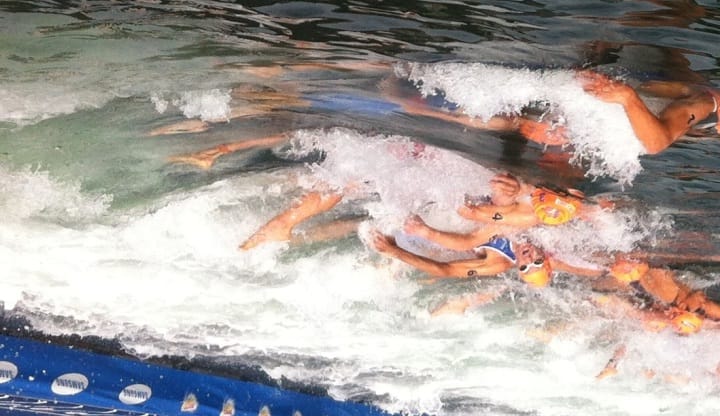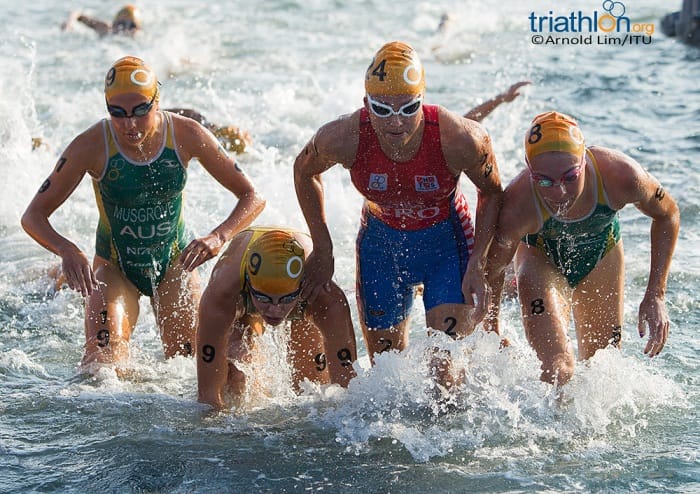As you swim, have you ever wondered how much of your arm stroke effort is wasted? What percentage really goes into pushing you forwards through the water and what is lost as water movement down, to the side and into eddies?
The technical term for this is ‘propelling efficiency’ and it makes a direct contribution to your overall efficiency as a swimmer. If more of your effort creates forwards propulsion and less is lost as water movement then you become a faster and more efficient swimmer.
When you work on your catch and pull technique to press the water backwards with good timing you are working on improving this propelling efficiency.
Swimmers vs. Triathletes
Last year we designed the exciting new range of HUUB wetsuits with Dean Jackson and top sports science Professor Huub
Toussaint (we liked his name so much Deano named the company after him!). As well as a guru on minimising drag in wetsuits, Huub is also the world leading sports scientist looking at propulsion in swimming.
In 1990 he conducted a study comparing high level swimmers and triathletes in the water [1]. The results were fascinating. At the same swimming speed, the triathletes converted 44% of their work output into propulsive power whilst the swimmers converted 61%. A very large difference in propelling efficiency highlighting the superior stroke technique of the swimmers over the triathletes.
This study looked at national and international standard athletes. However if you are a little lower down the pecking order yourself then you can expect your propelling efficiency to be lower with the majority of your effort lost into the water. Your figure might be in the 10-40% range. At the other end of the spectrum, Huub has measured propelling efficiencies as high as 80% in Olympic swimmers at racing speed.
Propelling Efficiency And Effort
Huub’s study compared swimmers all moving at the same speed. What happens to your propelling efficiency when you vary your effort from slow to fast swimming? You may find the answer quite surprising: As you work harder, your propelling efficiency improves and as you slow down it gets worse. In other words, if you increase your effort (e.g. by 10%) you get a greater return in propulsion (e.g. great than 10%). Conversely, drop your effort by 10% and you lose more than 10% in propulsion.
Although this change in efficiency with effort is well recognised by sports scientists, there is very little high quality data out there to quantify it for human swimmers. However, we can get a rough idea by looking at studies of fish. Webb studied trout swimming over their full speed range [2]. The results show a very strong relationship :
We have to be careful with this data as it relates to fish not humans but the strength of the relationship is striking. At slow speeds over 80% of their effort is lost into the water whilst when moving quickly they become much more efficient, losing only 20%. The hydrodynamics of why this happens is complex and beyond the scope of this blog but the key point to appreciate is how been overly gentle with the water is actually extremely inefficient.
(In an interesting aside, Webb noted that the fish in the study were reluctant to swim very gently, perhaps innately recognising the inefficiency of doing so!)
Efficiency Folklore
Much of the information out there in swimming books and on the internet purely focuses on decreasing your drag to make you a more efficient swimmer. For that reason it’s hardly surprising if in your mind you equate efficiency with reducing drag but really that’s only half the story. Your overall efficiency is a combination of your propelling efficiency and your drag profile.
You could say:
overall efficiency = propelling efficiency x drag efficiency
It’s important to appreciate that both elements are of equal importance, not one over the other. If your propelling efficiency is poor then you can work all you like on reducing drag but you will only make small improvements in efficiency.
Implications
If you are a bit of a swim geek (like us!) then hopefully you found that interesting. But what practical conclusions can we draw?
Here are our thoughts:
1) To become a more efficient swimmer, work on both your propulsive technique (e.g. catch and pull) and reducing drag (e.g. balance, alignment and kick). Don’t be sold on the idea that one is more important that the other or more of a priority to improve your stroke efficiency.
2) As we discussed last week on the blog be careful with the notion of swimming ‘effortlessly’ to become more efficient. As we have seen above, swimming too gently actually reduces your overall efficiency. This is one of the main reasons why swimmers trying to glide effortlessly down the pool become very frustrated with their lack of speed.
3) Don’t become a ‘technique hermit’, shunning all swim specific fitness training and solely focusing on swimming drills. The more swim fit you are, the higher effort you can sustain and therefore the more efficient you will be. Swim fitness is a vital ingredient of an efficient swimmer!
4) A key area of development for the Bambino Swim Type is better rhythm in the stroke. Although this involves turning the arms over quicker, the result is normally a reduction in effort, not an increase. This happens because the Bambino has such a poor feel for the water that their propelling efficiency is very low indeed and by lifting their stroke rhythm this improves.
5) Don’t use this as an excuse to muscle the water, that’s not what we’re talking about here. Efficient propulsion is generated through pressing the water in the right direction with good rhythm and timing. Whilst it certainly does not feel effortless, the catch should not be a forceful movement either.
Swim Smooth!
[1] Toussaint HM. Differences in propelling efficiency between competitive and triathlon swimmers. Med Sci Sports Exerc 1990;22:409-415.
[2] Webb PW. The swimming energetics of trout II: Oxygen consumption and swimming efficiency. J Exp Biol 1971;55:521-540








